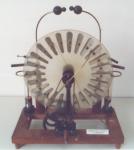

 Menu
Menu
|
Function Useful in several experiments of electrostatics. |

| ||
|
|||
|
Description It is formed by a ball of elder hang to a thread hanging from an insulating pole. | |||
|
Function To show the electric charge distribution on metals. |

| ||
|
|||
|
Description A cylindrical metallic container hangs from three columns placed at 120 degree angles. A double lid, that fits perfectly on the cylinder, holds a metallic sphere insulated by an insulating bar that slides along the cover axis. By placing the charged sphere inside the cylinder, the external surface is charged by induction so that the little balls of the pendulums are attracted. If we put the sphere in contact with the internal surface of the cylinder we can verify that all the charge has passed into the cylinder. | |||
|
Function To show the ignition of a gas mixture thanks to an electric discharge. |

| ||
|
|||
|
Description It is formed by a brass tube with a polished wooden handle. Near the closed end an ebonite cylinder crossed by a brass wire is fixed. The brass wire ends near the opposite side of the tube and carries an outside sphere. We fill the tube with a mixture of hydrogen and air. We close with a cork and we bring it near the conductor of an electrostatic machine. The external discharge is repeated in the internal interruption and it provokes the ignition of the mixture. | |||
|
Function To show electric discharges across low pressure air. |

| ||
|
|||
|
Description It is formed by a glass insulating ball, with a key and a screw connection to connect it to a pneumatic pump and by a cast iron basis polished with emery that is possible to place it on the plate of a pneumatic pump. The two conductors end with 18 mm spheres. One can be substituted by a point. The above conductor slides at friction along the axis of a set of leather disks, pressed as a gland, that assures a perfect seal. | |||
|
Function Production of static electricty. |

| ||
|
|||
|
Description Tinfoil strips placed on two rotating disks charge through rubbing and transmit the charges to two combs that store them in two capacitors (Leyden jars). | |||